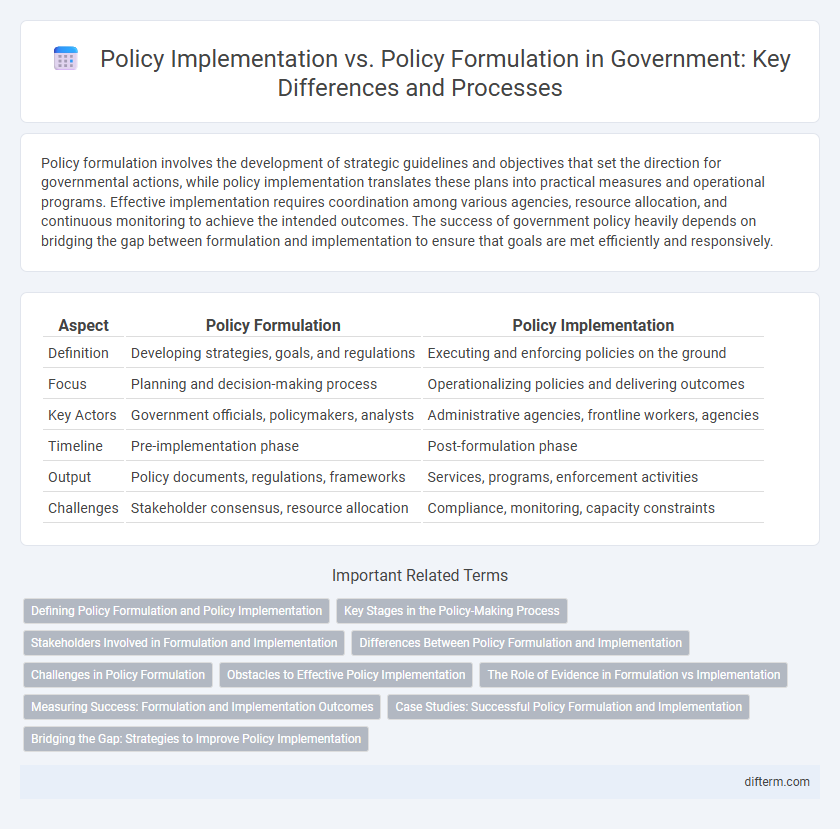Policy formulation involves the development of strategic guidelines and objectives that set the direction for governmental actions, while policy implementation translates these plans into practical measures and operational programs. Effective implementation requires coordination among various agencies, resource allocation, and continuous monitoring to achieve the intended outcomes. The success of government policy heavily depends on bridging the gap between formulation and implementation to ensure that goals are met efficiently and responsively.
Table of Comparison
| Aspect | Policy Formulation | Policy Implementation |
|---|---|---|
| Definition | Developing strategies, goals, and regulations | Executing and enforcing policies on the ground |
| Focus | Planning and decision-making process | Operationalizing policies and delivering outcomes |
| Key Actors | Government officials, policymakers, analysts | Administrative agencies, frontline workers, agencies |
| Timeline | Pre-implementation phase | Post-formulation phase |
| Output | Policy documents, regulations, frameworks | Services, programs, enforcement activities |
| Challenges | Stakeholder consensus, resource allocation | Compliance, monitoring, capacity constraints |
Defining Policy Formulation and Policy Implementation
Policy formulation involves the systematic process of developing strategies and decisions that address public issues through research, stakeholder engagement, and drafting legislative or regulatory frameworks. Policy implementation refers to the execution phase where government agencies and institutions translate formulated policies into actionable programs, ensuring adherence to legal standards and achieving targeted outcomes. Effective governance depends on the alignment of both stages to optimize public service delivery and policy impact.
Key Stages in the Policy-Making Process
Policy formulation involves defining objectives, analyzing alternatives, and selecting viable options, serving as a critical preparatory phase in the policy-making process. Policy implementation translates these formulated plans into actionable programs, managing resources, coordinating agencies, and ensuring compliance with established guidelines. Key stages include agenda-setting, formulation, adoption, implementation, and evaluation, each essential for effective governance and achieving policy goals.
Stakeholders Involved in Formulation and Implementation
Policy formulation primarily involves government officials, legislators, subject matter experts, and advocacy groups who contribute to drafting and shaping the policy framework. Policy implementation engages a broader range of stakeholders, including public administrators, frontline workers, local governments, and community organizations responsible for executing and monitoring the policy directives. Effective collaboration between these stakeholders ensures alignment between policy objectives and practical application, enhancing overall governance outcomes.
Differences Between Policy Formulation and Implementation
Policy formulation involves the development of strategies, goals, and detailed plans through research, analysis, and stakeholder consultation to address societal issues. Policy implementation translates these plans into actionable programs, regulations, and procedures, requiring coordination among government agencies and resource allocation. Key differences include formulation's focus on design and decision-making versus implementation's emphasis on execution, monitoring, and enforcement of policies.
Challenges in Policy Formulation
Policy formulation faces challenges such as balancing diverse stakeholder interests, resolving conflicting policy goals, and addressing limited access to accurate data. Complex political dynamics and resource constraints hinder the development of coherent and effective policy options. These obstacles often result in delays and suboptimal decisions before implementation even begins.
Obstacles to Effective Policy Implementation
Obstacles to effective policy implementation include inadequate resource allocation, ambiguous policy directives, and resistance from stakeholders. Bureaucratic inertia and lack of coordination among government agencies often hinder the translation of policy formulation into tangible outcomes. Monitoring and evaluation frameworks are frequently weak, limiting timely adjustments and accountability throughout the implementation process.
The Role of Evidence in Formulation vs Implementation
Evidence plays a critical role in policy formulation by providing empirical data and analysis that guide decision-making and shape policy goals. During policy implementation, evidence is used to monitor progress, evaluate effectiveness, and inform necessary adjustments to ensure desired outcomes. The dynamic interplay between evidence-based formulation and evidence-informed implementation enhances transparency, accountability, and policy success.
Measuring Success: Formulation and Implementation Outcomes
Measuring success in policy formulation requires assessing the clarity of objectives, stakeholder engagement, and feasibility studies that guide effective implementation. Policy implementation success is evaluated through outcome metrics such as compliance rates, resource utilization efficiency, and the achievement of predetermined social or economic goals. Comparative analysis of formulation and implementation outcomes reveals gaps that inform continuous improvements in government strategies and public administration.
Case Studies: Successful Policy Formulation and Implementation
Successful policy formulation often hinges on thorough stakeholder analysis and evidence-based research, as demonstrated by Singapore's housing policy that transformed urban living conditions through integrated planning and public engagement. Case studies from Sweden reveal that effective policy implementation requires clear communication channels and robust feedback mechanisms to adapt initiatives like the national environmental strategy in real time. The Canadian healthcare system exemplifies how aligning policy design with resource allocation and intergovernmental collaboration can achieve sustained improvements in public health outcomes.
Bridging the Gap: Strategies to Improve Policy Implementation
Effective policy implementation requires clear communication channels and resource allocation to translate policy formulation into tangible outcomes. Establishing robust monitoring and evaluation frameworks ensures accountability and adapts strategies based on real-time feedback. Engaging stakeholders throughout the process fosters collaboration, reducing discrepancies between policy design and on-the-ground execution.
policy implementation vs policy formulation Infographic

 difterm.com
difterm.com